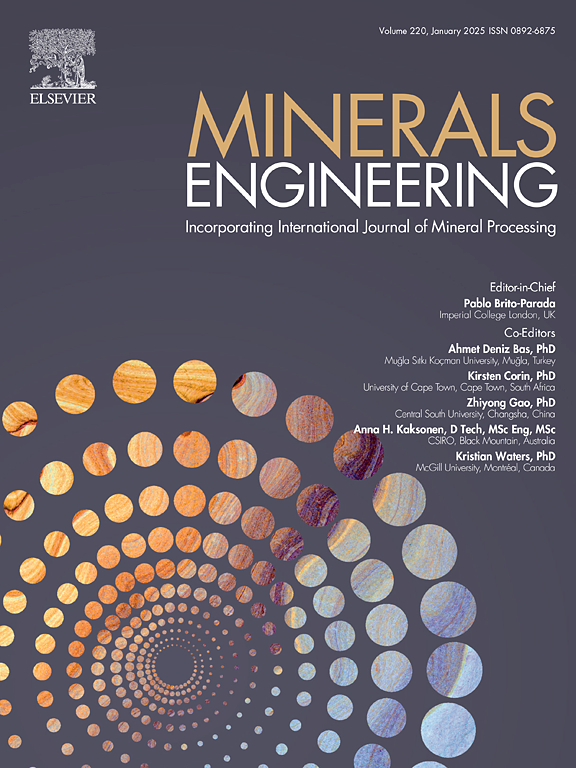在浮选过程中,表面迁移率在提高泡沫排水和减少夹带中的作用
IF 5
2区 工程技术
Q1 ENGINEERING, CHEMICAL
引用次数: 0
摘要
在浮选过程中,改善泡沫排水是减少矸带和提高精矿质量的关键。在我们之前通过空气-水界面的氢键网络调节界面迁移率来促进泡沫(无颗粒)排水的工作的基础上,本研究将研究扩展到工业相关条件下的含颗粒泡沫。实验室规模的浮选实验在Microcel™柱上进行,工业样品具有不同但可控的粒度分布,并进行再磨。泡沫成像用于评估泡沫的气泡行为。结果表明,低剂量甘油显著提高了浮选泡沫的排泡性,强调了界面氢键在调节三相体系界面迁移率和泡沫排泡性中的作用。排水量的改善程度取决于气泡的大小,而气泡大小又受颗粒特性的影响。细的、解放良好的颗粒产生小的、刚性的气泡,阻碍水的排出,而粗的颗粒产生更大的、更可移动的气泡,促进更快的排出,但可能由于气泡合并而降低精矿质量收率。这些发现为调整泡沫结构和表面流动性以改善浮选性能提供了新的见解。本文章由计算机程序翻译,如有差异,请以英文原文为准。

The role of surface mobility in enhancing froth drainage and reducing entrainment in flotation
Improving froth drainage is crucial for reducing gangue entrainment and increasing concentrate quality in flotation. Advancing our previous work on promoting foam (particle-free) drainage via modulating interfacial mobility through hydrogen bonding networks at the air–water interface, this study extends the investigation to particle-laden froths under industrially relevant conditions. Laboratory-scale flotation experiments were performed in a Microcel™ column with industrial samples of varying but controlled particle size distributions and regrinding. Froth imaging was employed to assess froth bubble behaviour. Results reveals that low-dosage glycerol significantly enhances flotation froth drainage, underscoring the role of interfacial hydrogen bonding in modulating interfacial mobility and froth drainage in three-phase systems. The extent of water drainage improvement depends on bubble size, which is influenced by particle characteristics. Fine, well-liberated particles generate small, rigid bubbles that hinder water drainage, whereas coarser particles promote larger, more mobile bubbles that facilitate faster drainage but may reduce concentrate mass yield due to bubble coalescence. These findings provide new insights into tailoring froth structure and surface mobility for improved flotation performance.
求助全文
通过发布文献求助,成功后即可免费获取论文全文。
去求助
来源期刊

Minerals Engineering
工程技术-工程:化工
CiteScore
8.70
自引率
18.80%
发文量
519
审稿时长
81 days
期刊介绍:
The purpose of the journal is to provide for the rapid publication of topical papers featuring the latest developments in the allied fields of mineral processing and extractive metallurgy. Its wide ranging coverage of research and practical (operating) topics includes physical separation methods, such as comminution, flotation concentration and dewatering, chemical methods such as bio-, hydro-, and electro-metallurgy, analytical techniques, process control, simulation and instrumentation, and mineralogical aspects of processing. Environmental issues, particularly those pertaining to sustainable development, will also be strongly covered.
 求助内容:
求助内容: 应助结果提醒方式:
应助结果提醒方式:


